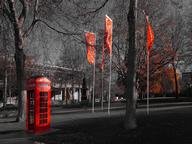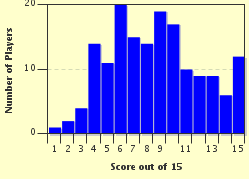Quiz Answer Key and Fun Facts
1. The writers of the Romantic Age emphasized heart and soul over mind. Readers encounter such a focus in "We Are Seven", a poem in which a logical man grows frustrated with a spiritual and sentimental little girl who insists that she and her siblings number seven instead of five although two of them are dead. Which individual, who became Poet Laureate of England in 1843, was the author of "We Are Seven"?
2. This poet represented the Romantic spirit, for not only was he a tenant farmer as was his father, but he wrote his poetry and songs in his native dialect. Take some of the lyrics to "For a' that and a' that", for example: "What though on homely fare we dine, / Wear hodden grey, and a' that. / Gie fools their silks, and knaves their wine, / A Man's a Man for a'that." Who was the author of this song and such poems as "Holy Willie's Prayer"?
3. This writer composed two companion poems that were both entitled "Holy Thursday". One of them speaks of innocence with such words as, "The hum of multitudes was there, but multitudes of lambs, / Thousands of little boys & girls raising their innocent hands", while the other speaks of corruption with such words as "In a rich and fruitful land, / Babes reduced to misery, / Fed with cold and usurous hand?" What poet, artist, and prophet would this be?
4. In 1792, this writer published "A Vindication of the Rights of Woman", one of the earliest pieces of feminist philosophy, in response to de Talleyrand-Perigord's argument that women should receive no education beyond learning how to be good wives, mothers, and housekeepers. What is the name of this writer, who had a few scandalous affairs and attempted suicide on a couple of occasions?
5. Earlier in his life, this romantic soul married his wife so that he could create a population for an idealistic commune he and a friend planned to establish in Pennsylvania. While the experiment never happened, he did find a use for her in his poetry. In "The Eolian Harp", he writes of her admonishing look when he expresses his pantheistic thoughts while listening to the music created by a wind instrument. Who was this poet as well as prose author of "Biographia Literaria"?
6. Jane Austen was more balanced than most of her free-spirited literary contemporaries. Her father was a rector, the head minister of a parish. Perhaps that explains why so many of the main characters in her novels are also clergymen. Which of the following is NOT a character who is also a minister in one of Jane Austen's novels?
7. Desperate for an income to support himself and his family, this individual turned to writing at the age of thirty-six. His first publication was based on his addiction to "the pleasures and pains of opium" and was titled "Confessions of an English Opium-Eater". Who is this writer, who also indulged his macabre fantasies in such writings as "On Murder Considered as One of the Fine Arts"?
8. Wordsworth is often credited with resurrecting the sonnet and redefining its purpose; however, another of the Romantic era had success with sonnets before he did. This poet married at age fourteen, bore her husband twelve children, and then separated from him because of his abuse, infidelity, and financial irresponsibility. Who was this woman who published "Elegiac Sonnets, and Other Essays" in 1784 to provide for her children after their father was imprisoned for debt?
9. This poet was rejected by his native English society after he abandoned his wife to run off with another woman he truly loved; he justified his abandonment with his belief that cohabitation without love is immoral. Eventually, he wrote a poetic drama entitled "Prometheus Unbound" that portrays Prometheus's refusal to ask for Zeus's forgiveness as a heroic act. Who was this writer who used Prometheus to help him argue that sometimes we have to disobey authority to do what is right?
10. As the eighteenth century was coming to a close, many British entertained the belief that the apocalypse (from the Bible's "Revelation") was near, particularly because of the the atrocities resulting from the French Revolution as well as England's own industrial revolution. Some poets managed to capture this theme, even after the nineteenth century had started. What is the title of Byron's poem that portrays human beings killing one another off after the sun is extinguished?
11. This poet was the fulfillment of the Romantic ideal for whom primitivists had been searching, the "natural poet", the common man speaking to common men. He wrote the poem "I Am", which includes the following lines: "I long for scenes where man hath never trod, / A place where woman never smiled or wept, / There to abide with my Creator, God, / And sleep as I in childhood sweetly slept, / Untroubling and untroubled where I lie, / The grass below--above the vaulted sky". Who was this minimally educated poet who spent most of the second half of his life in an asylum?
12. This writer began as a writer of narrative poetry but gave up, so he claimed, after he felt Byron outperformed him. He then devoted his attention to prose and is now credited with having created the true historical novel. Who was this writer of Scottish descent, awarded a title of baronet in 1820, who penned such novels as "Old Mortality" and "The Heart of Midlothian"?
13. As poetry began to become more personal during the Romantic era, personal letter writing became more and more esteemed as an art form in itself. What famous poet wrote the following words in his letter "To Benjamin Bailey": "I am certain of nothing but the holiness of the Heart's affections and the truth of Imagination--What the imagination seizes as Beauty must be truth" and "The setting sun will always set me to rights--or if a Sparrow come before my Window I take part in its existence . . . "? (Think of who wrote poems about similar themes and subjects--imagination (fancy), beauty, truth, becoming one with a bird . . . )
14. The Gothic novel was a relatively new type of fiction which became most prominent during the Romantic era. Most are familiar with Mary Shelley's "Frankenstein", but how familiar are you with some of the era's other gothic tales? Which of the following is NOT a gothic novel written during the Romantic Age?
15. What many consider William Wordsworth's masterpiece was not published until 1850 after his death and after he had labored over it for most of his life. It is most significantly romantic because it revolves around the metaphor of several physical journeys through many natural scenes that are compared to Wordsworth's journey as a poet and spiritual being. What is the name of this poem eventually published in fourteen Books?
Source: Author
alaspooryoric
This quiz was reviewed by FunTrivia editor
agony before going online.
Any errors found in FunTrivia content are routinely corrected through our feedback system.

